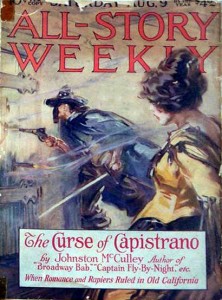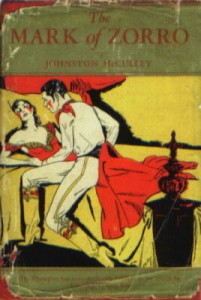 You probably know this story better under the title The Mark of Zorro. First serialized in five segments in 1919 in All-Story Weekly, The Curse of Capistrano was then adapted into the feature film The Mark of Zorro in 1920 (see Movie Monday for more information).
You probably know this story better under the title The Mark of Zorro. First serialized in five segments in 1919 in All-Story Weekly, The Curse of Capistrano was then adapted into the feature film The Mark of Zorro in 1920 (see Movie Monday for more information).
So here’s something you should know about me, right off the bat. I’ve always been a bit of a Zorro fan. I liked the two Antonio Banderas Zorro films. Â I think the climactic duel between Tyrone Power and Basil Rathbone in the 1940 version is one of the best pure swordfights I’ve ever seen. I even liked the goofy Italian version that came out in 1975 starring Alain Delon and Stanley Baker (“la-la-la-la-la-la, Zorro’s back”).
So it was a bit of a shock to read a version of the Zorro story in which we aren’t told right up front that Don Diego Vega is Zorro. I mean, it doesn’t take a genius to figure it out, considering McCulley never gives us any other suspects, but in this pre-movie (pre-Zorro movies, not all movies), pre-comic book era, the concept of the secret identity was not the universal cultural constant it is now. So I guess McCulley felt justified in playing coy with it.
The book opens as blustery Sergeant Pedro Gonzales complains about the way this Zorro always seems to elude the soldiers sent after him. He always strikes where they are not. We are then introduced to foppish Don Diego Vega, who listens to the sergeant brag for a while about what he would do to Zorro if he ever caught him. Vega then excuses himself, claiming fatigue.
Not long after, the wily Zorro appears. He holds the other soldiers at bay with a pistol, then outfences Gonzales, humiliating him. After the highwayman departs, Don Diego Vega returns and is shocked at the commotion that has gone on in his absence. The opening scene finally ends after four chapters, and we finally get into the meat of the story…
 And it’s a romance. The big central dilemma: three men vie for the hand of Senorita Lolita Pulido, daughter of a local caballero whose family has fallen into disfavor with the greedy  governor and so has lost much of its fortune. Before you laugh at the name, keep in mind that this story came out over 35 years before Vladimir Nabokov changed the meaning of Lolita forever.
And it’s a romance. The big central dilemma: three men vie for the hand of Senorita Lolita Pulido, daughter of a local caballero whose family has fallen into disfavor with the greedy  governor and so has lost much of its fortune. Before you laugh at the name, keep in mind that this story came out over 35 years before Vladimir Nabokov changed the meaning of Lolita forever.
The first suitor is Don Diego Vega, scion of a rich and powerful family which would restore the Pulido fortunes almost overnight. But he is pallid and weak, constantly complaining of fatigue and unwilling to put even a little effort into romance. The second is Captain Ramon, commandante of the local presidio, who is not as rich as Vega, but more dashing and has powerful political connections. He could also restore the Pulido family’s fortune by repairing their standing with the governor.
The third suitor is the bandit, Senor Zorro. He is romantic and brave, and Lolita falls for him instantly, in spite of the fact that if her love came to light, it would ruin the family’s fortunes even further.
The plot runs similar to the movie, but with a few more chances for Zorro to show his stuff. For instance, there are a couple more scenes where Don Diego Vega takes his leave of someone, only to have Zorro show up in the same place less than a page later. The one big surprising contrast between the book and the movie is that Sergeant Gonzales actually proves to be rather cunning and clever in some scenes, which is unexpected and nice.
But once again, the romance of Lolita Pulido is the central aspect of the plot. Zorro interrupts Captain Ramon pressing his suit too forcefully upon Lolita and humiliates the captain in a fencing match. Ramon is forced to apologize on his knees and immediately sends a letter to the governor accusing the Pulidos of being in league with Zorro. Zorro finds a copy of the letter and threatens dire consequences if the letter is ever sent (not knowing it has been sent already–perhaps the one instance in the book where Zorro makes even a tiny mistake).
And the beating of the magistrate after the rigged trial of Fray Felipe prompts the local young caballeros to form a posse and ride out after Zorro, since the soldiers from the presidio are already pursuing him in the wrong direction. But they stop for refreshments at the hacienda where Don Diego Vega is visiting his father, Don Alejandro, and have themselves a little party. And moments after Diego excuses himself to go to bed early, Zorro appears and rouses the assembled caballeros to follow him and fight against injustice.
So suddenly Zorro has a little army, although it’s not certain he’ll keep it after they sober up. But when the governor arrives and has the Pulidos arrested and thrown into the jail with the common criminals (including sweet, innocent Lolita, the cad!) pending trial, the caballeros join with Zorro in a jailbreak.
While the caballeros take the Pulidos to safety, Zorro confronts the governor and Captain Ramon and kills the captain in a duel after forcing him to tell the truth about the Pulidos. The governor refuses any pardon, however, Â and Zorro is forced to flee his soldiers. To make things worse, Lolita has fled back to the city from clever Sergeant Gonzales, and Zorro and Lolita end up trapped in the local inn, surrounded by the soldiers the governor brought with him.
All seems lost when the caballeros ride to the rescue and convince the governor that the entire south will turn against him if he does not relent, cease the torment of the natives and the friars, and pardon Zorro, who is revealed to be none other than Don Diego Vega! He tells the story of how he trained in secret for years to take up the fight against injustice, and then sweeps Lolita off her feet.
The book has some good action and good moments, but it also has some big problems. Don Diego Vega is a very one-note character, constantly complaining about fatigue, without the wit and charm that Fairbanks brought to the role. The climactic duel against Ramon comes too early, and then Zorro is trapped and must himself by rescued by the cavalry.
The movies would end up fixing these  problems, making Vega more interesting, introducing the fact that he is Zorro early rather than late,  eliminating Zorro’s army at the end in all the versions after the first, and making his one-on-one duel with the local commandante the climax.
If you want to read it yourself, the book is in the public domain and available at manybooks.net. Next week, I’m thinking about looking at Zorro’s predecessor, the Scarlet Pimpernel.




